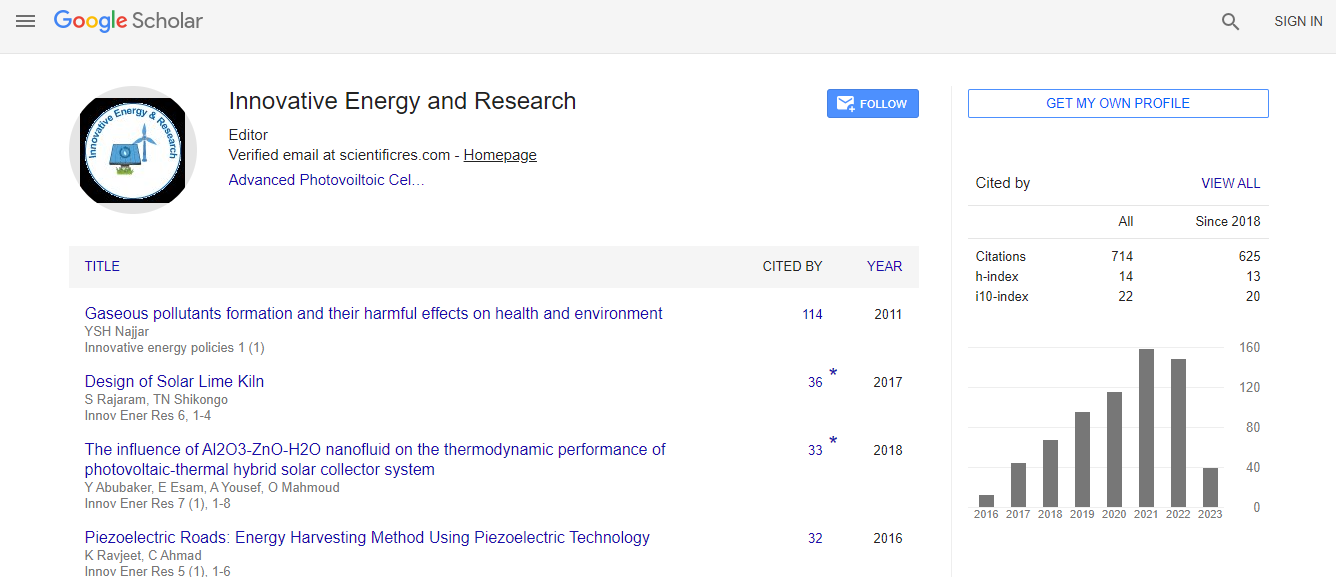Our Group organises 3000+ Global Conferenceseries Events every year across USA, Europe & Asia with support from 1000 more scientific Societies and Publishes 700+ Open Access Journals which contains over 50000 eminent personalities, reputed scientists as editorial board members.
Open Access Journals gaining more Readers and Citations
700 Journals and 15,000,000 Readers Each Journal is getting 25,000+ Readers
Google Scholar citation report
Citations : 712
Innovative Energy & Research received 712 citations as per Google Scholar report
Innovative Energy & Research peer review process verified at publons
Indexed In
- Google Scholar
- Open J Gate
- Genamics JournalSeek
- RefSeek
- Hamdard University
- EBSCO A-Z
- Publons
- Euro Pub
- ICMJE
Useful Links
Recommended Journals
Related Subjects
Share This Page
Insights into the dynamic interplay between mobile ions and photovoltaic performance of organometal halide perovskites
20th International Conference on Advanced Energy Materials and Research
Byungwoo Park
Seoul National University, South Korea
Posters & Accepted Abstracts: Innov Ener Res
Abstract
Among various photovoltaic energy conversion systems, organometal halide perovskite (OHP) has gathered much attention over the past few years, as the OHP-based solar cells have demonstrated high power conversion efficiency (> 22%) and long-term stability. However, the mixed ionic/electronic conducting nature of OHPs allows the migration of mobile ionic species (vacancy and/or interstitial defects) during solar cell operation, which is pinpointed as the major cause of anomalous current-voltage (J-V) hysteresis. The timescales of ion diffusion span the range between sub-second to more than a minute, and are highly dependent on the types of ions and OHPs’ nanostructures. Such ion diffusion, in combination with electron-hole recombination, results in the complex time-dependent temporal evolution of photovoltage and photocurrent, emphasizing the importance of frequency- and time- dependent responses of solar cells to enable high photovoltaic performance. Herein, the photovoltaic performance of solar cells based on (FAPbI3)0.83(MAPbBr3)0.17 and Cs-doped one (FA stands for (NH2)2CH+, and MA for CH3NH3 +) was addressed utilizing various analysis methods such as impedance spectroscopy, transient voltage and current measurements coupled with light/bias control (e.g., photovoltage rise, open-circuit voltage decay, photocurrent profile, etc.) to reveal the influence of mobile ions on the photovoltaic performance.The variations of OHPs’ properties in microscopic scale were rationally minimized (such as grain size, crystallographic orientation, crystallinity, etc.) by minimally changing the processing parameter (e.g., annealing time) to reduce their influences on the photovoltaic performance, thereby distinguishing the role of nanoscale defects. Nanoscopic analyses utilizing noise spectroscopy were conducted to comprehend the effects of mobile ions on the electronic traps and thereby the photocurrent behaviors. These analyses strongly suggest that the time-dependent photocurrent and/or photovoltage behavior are strongly correlated to the nanoscale ionic defects and their migrations, providing deeper understanding of the operation of OHP-based solar cells.Biography
E-mail: byungwoo@snu.ac.kr

 Spanish
Spanish  Chinese
Chinese  Russian
Russian  German
German  French
French  Japanese
Japanese  Portuguese
Portuguese  Hindi
Hindi 
